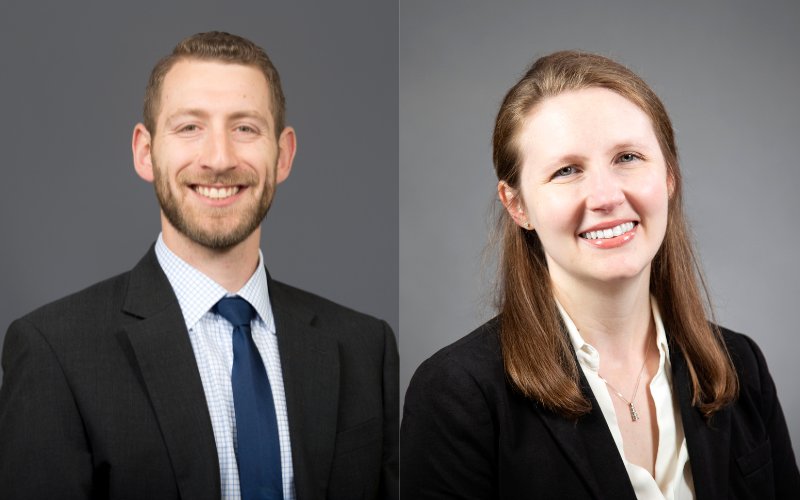DHS-Funded Research Examines Long-Term Recovery for K-12 Schools After Tragedies

ALBANY, N.Y. (May 20, 2025) — When a disaster devastates a school, whether a hurricane, wildfire or violence, the aftermath extends beyond physical damage. Recovery is a complex, emotional and years-long process that requires coordination between educators, mental health professionals, government agencies and the broader community.
Matthew Crayne, associate professor of management in the Massry School of Business, and Samantha Penta, associate professor of emergency preparedness in the College of Emergency Preparedness, Homeland Security and Cybersecurity, are working to uncover the most effective strategies for helping schools in their long-term recovery after a threat. Their study, funded by the Department of Homeland Security (DHS), examines school disaster responses across the United States, examining the differences in approaches to rebuilding infrastructure, restoring learning environments and supporting the long-term well-being of students and staff.
Why Study Long-Term Disaster Recovery?
Schools serve as anchors for their communities. Beyond education, schools provide support for many people, from the students and their families to the school staff and administration. When disasters strike, interruption of school services can have cascading effects on student performance, mental health and even regional recovery. This research was started because DHS is looking to understand crisis management and create a toolkit for schools to use to prepare for and recover from crises.
“The DHS is interested in understanding the entire range of threats and hazards that can be faced by school buildings and school personnel. Our part of the project is focused on the recovery. Once a school has had a catastrophic event — a disaster, a school shooting, targeted violence, any of those things — we are asking, ‘What do those different cases have to do to get the school back to operating and fulfilling its mission?’” explained Crayne.
The team was motivated because the long-term recovery process is a vastly understudied aspect of school crises. “Compared to things like preparedness and response, recovery is still kind of an underdog,” Penta said. “It's not as captivating. Nobody is standing in a windbreaker on a Jeep to do recovery work. Long-term recovery doesn't get the same attention that immediate recovery response does. So we knew there was probably not as much attention on this area of response.”
The research isn’t as simple as figuring how to handle physical repair. “It's not just about we get the building up and running, that's part of it,” Crayne said. “We are asking, how do you get people back in the building, classes started, the organization, the institution operating, and how do you make the school what it once was socially? How do you or can you restore the social and emotional and psychological value that the school provides? And are there best practices to do that?”
According to team, the DHS has invested in this research because dangerous events, like climate change related disasters or school shootings, remain a consistent threat. The DHS is looking to create a toolkit that will provide best recovery practices to help districts nationwide prepare more effectively for and rebound from catastrophic events.
“The government's objective at the end of the day is to take what we produce and the research from the other folks on the broader sections of this project and put the findings in a place where they can be delivered to school districts and school buildings,” said Crayne. “DHS wants to be able to distribute tools created by researchers, funded by the government, to help plan for and recover from if you experience these traumatic events.”
The Importance of a Multidisciplinary Team
While there are studies on the effect that tragedies have on students, Penta and Crayne found that there was less research being done on long-term recovery and the school systems themselves. This means that their work would contribute to an under-examined topic, and they knew that this would require a variety of perspectives.
Crayne said it was vital to build a well-rounded team. “I knew that I was not going to be able to address the scope of the questions here by myself,” he said. “I know how to ask scientific questions about people's experiences with traumatic or distressing events in the workplace. But I don't know nearly enough about the sociology or the mechanics of a disaster to ask questions efficiently and get real insights into how long-term recovery efforts happen. I was very fortunate to bring Sam on as co-investigator on the project.”
Beyond the lead researchers, Crayne said he needed the whole team to come to the project with different outlooks. “Historically, the specific guidance and work on K-12 school recovery itself from all angles is very limited, which is why a multidisciplinary team is important,” he said. “This includes our graduate research assistants, Stefana LoTempio and Jonathan Muller. Stefana is a criminology PhD student and Jonathan is an anthropology PhD student with a background in education. Having multiple perspectives is a real advantage.”
Reaching Beyond the Science Community
While this research is important for DHS, Crayne and Penta hope that their work will have an effect beyond the research community.
“I am motivated to do work like this because I think it is genuinely important,” Crayne said. “This is an opportunity to do something that has real, pragmatic and practical impacts that we can see and touch. We are talking to the people who are impacted directly. The response we get from our interviewees is universally a thank you. ‘Thank you for booking this time, for having this conversation and addressing these questions, because nobody else is. We want our stories to be told and we want to help. We want some good to come out of the tragedy that we've suffered.’ Being able to contribute to that tangibly has tremendous value as an academic.”
The team recently completed their literature review phase and has shifted focus to the next stage: interviewing people who have encountered tragedies in schools and learn from their experiences.
“We are starting to interview people who have had some kind of direct experience with a crisis in the school context, specifically with the recovery aspect of the school experience. Part of it may be that they were there when the event happened. But we are also interviewing people who can offer insight into what happens six months, one year, a couple of years later, after the event,” said Penta. “We are trying to capture a range of contexts and experiences, including different locations in the U.S., different kinds of hazards and different levels of experience in long-term recovery. We need to think about what is unique to certain kinds of events and their recovery.”
A Roadmap for Resilience
The team’s next steps are to analyze their interviews, identify patterns and eventually create recommendations. These will translate participant stories into actionable strategies. But one truth is already clear: Recovery isn’t a checkbox, it’s an ongoing process that demands policy changes, dedicated funding, and above all, listening to those who’ve lived through it.


